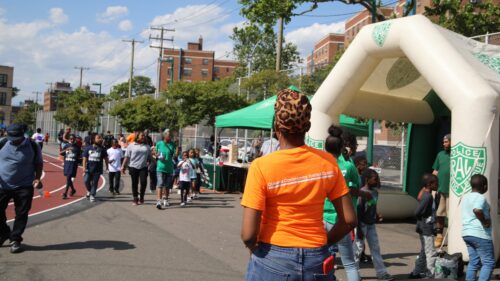Strong communities are safe communities. What would change if all of our policies—inside and outside of the legal system—reflected that basic truth?
When you hear the word “safety,” what comes to mind? You might imagine a safe place—your home, a local park, a place of worship—or the people you trust the most. Some of us think of somewhere quiet, away from the bustle and commotion, while others feel safest in a lively crowd. Or we might find safety when we can lose ourselves in a favorite activity: dancing, reading, boxing, painting.
All of those things—homes, human connection, public spaces, joy and creativity—are the hallmarks of safety in our lives. Yet these basic human needs rarely show up in conversations around public safety.
Talk of public safety usually centers on one thing: protection from crime. That’s a crucial need; there’s no doubt that we can’t be safe if we’re in danger of being harmed. But ask yourself, too: Can we really be safe if we’re facing the threat of eviction? If we can’t find a job to support our loved ones? If a mental illness goes untreated because we can’t access services?
When we think of public safety as the absence of crime, we risk overlooking all the things that need to be present for us to be safe—affordable homes, access to jobs and education, health care, vibrant public spaces, and more. Paradoxically, this leads to policies and practices that fail to reduce crime because they ignore—and even exacerbate—the needs that give rise to it.
Take the example of mass incarceration. The people who fill prisons and jails in the United States are disproportionately Black, Brown, and low-income. The system primarily affects people who, long before their arrest, have been deprived of equal access to quality education, decent housing, stable jobs, and needed services like mental health treatment—all due to systematic underinvestment in their communities. Instead of correcting these wrongs, mass incarceration inflicts even more trauma and disadvantage on the people it touches—the same factors that drive much crime in the first place.
Recognizing that things like housing, jobs, and mental health treatment are integral to public safety means pivoting to policies that are preventative instead of reactive. Instead of responding to crimes only after they have occurred, we can prevent them from happening in the first place by investing in strong, healthy communities. And that goes hand in hand with addressing the injustices that have created racial disparities in access to education, job opportunities, housing, health care, and other basic needs.
A holistic approach to public safety has to center on key areas of need, all of which guide our work at the Center:
- Mental health support. Our criminal legal system impacts a disproportionate number of people struggling with mental health crises. A shocking 54% of people in New York City’s notorious Rikers Island jails have a mental illness, exacerbated by a lack of access to care as well as inhumane conditions in the jails themselves. Linking people with untreated mental health needs to long-term care in the community—whether or not they have a criminal case—is crucial to lasting public safety.
- Addressing violence. Another priority is building community-based initiatives to prevent violence. As our groundbreaking research into the roots of gun violence has shown, many young people carry guns out of fear—fear that is often intensified by over-policing. By changing neighborhood norms and training respected members of the community as first responders to defuse conflicts, we can stop the spread of gun violence without adding to the harms of the system.
- Prioritizing local solutions. We also have to rethink our responses to crime by offering people who have been arrested meaningful opportunities for change through community-based services. Rather than setting up walls that prevent people from leading fulfilling lives in their communities, our responses can strengthen public safety by addressing the unmet needs that so often bring people into the legal system.
- Community empowerment. Finally, we need to place residents themselves at the center of the decisions and policies that impact their communities. That means supporting local, collective decision-making in everything from designing public spaces, to community events and resource fairs, to how money should be invested into the neighborhood.
Strong communities are safe communities. For too long, our systems have gotten that logic backwards, putting a narrow approach to punishing crime before investment in basic needs. When we cultivate the things that bring meaning, stability, and joy to people’s lives and communities, we lay the groundwork for real public safety.
